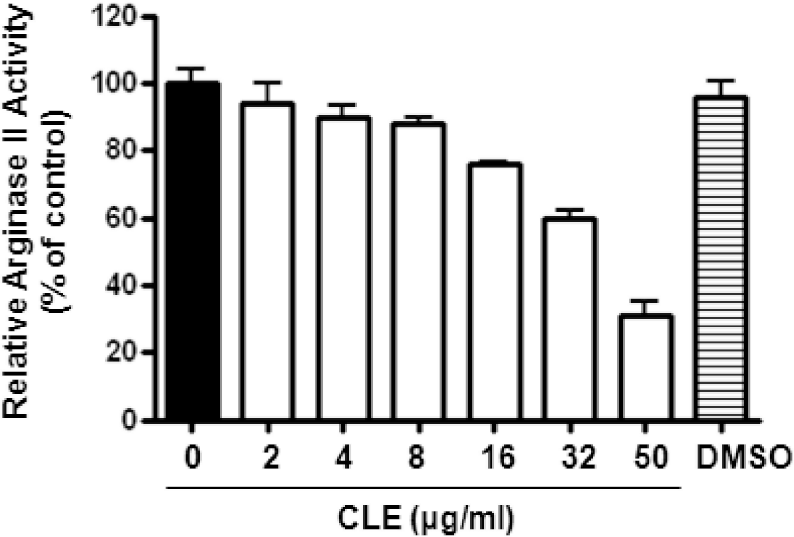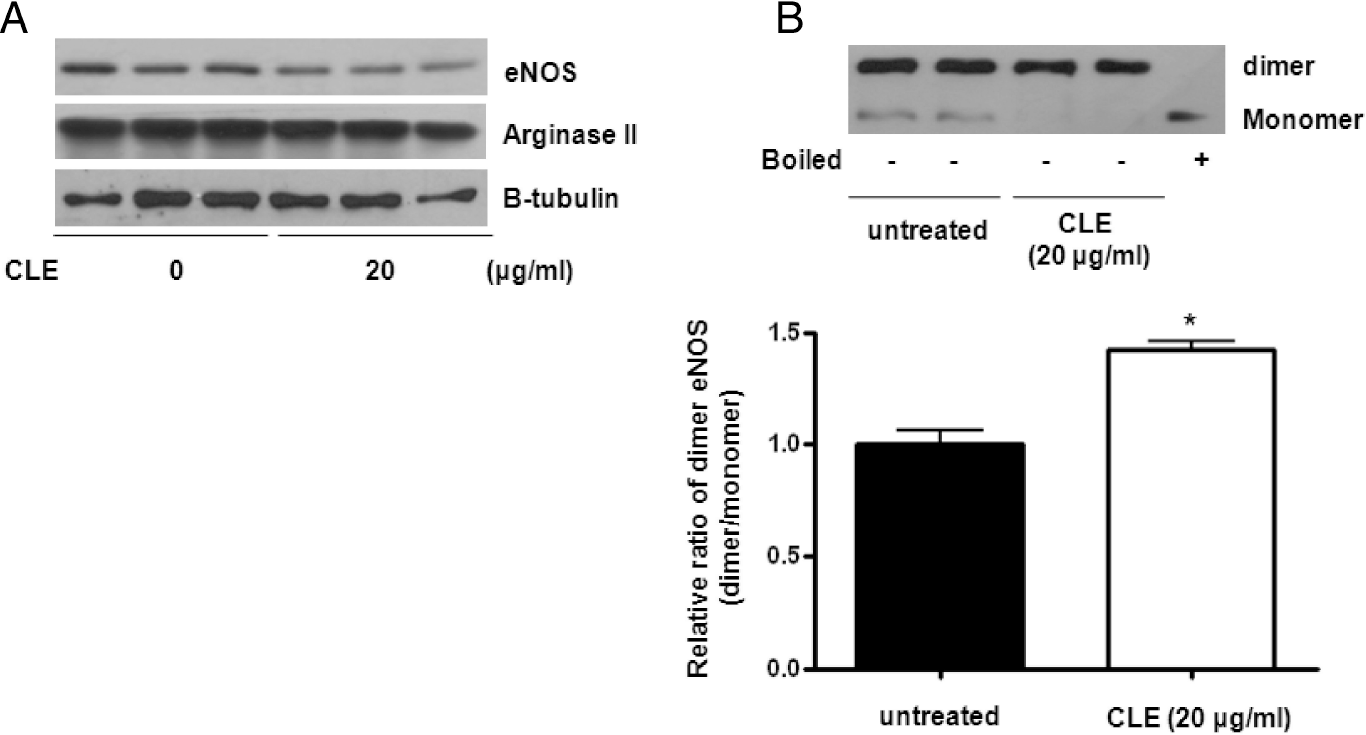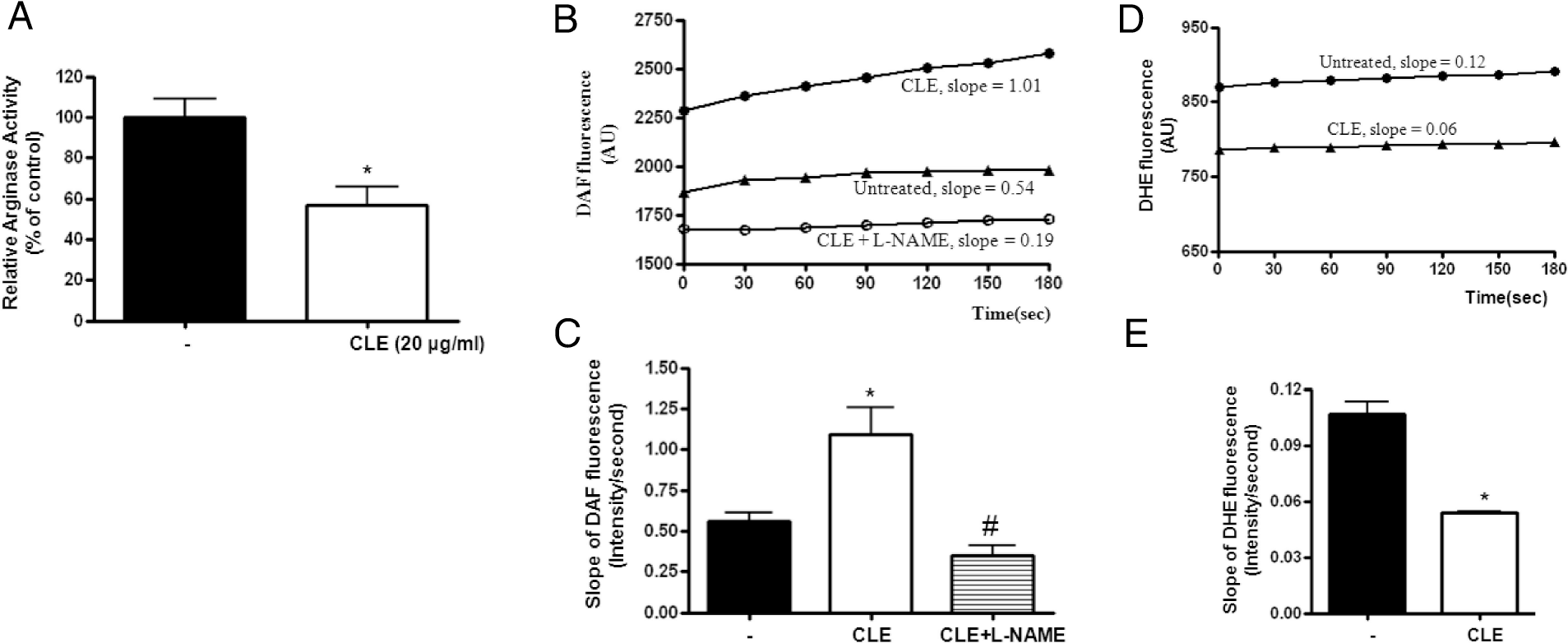Abstract
Caesalpinia sappan (C. sappan) is a medicinal plant used for promoting blood circulation and removing stasis. During a screening procedure on medicinal plants, the ethylacetate extract of the lignum of C. sappan (CLE) showed inhibitory activity on arginase which has recently been reported as a novel therapeutic target for the treatment of cardiovascular diseases such as atherosclerosis. CLE inhibited arginase II activity prepared from kidney lysate in a dose-dependent manner. In HUVECs, inhibition of arginase activity by CLE reciprocally increased NOx production through enhancement of eNOS dimer stability without any significant changes in the protein levels of eNOS and arginase II expression. Furthermore, CLE-dependent arginase inhibition resulted in increase of NO generation and decrease of superoxide production on endothelium of isolated mice aorta. These results indicate that CLE augments NO production on endothelium through inhibition of arginase activity, and may imply their usefulness for the treatment of cardiovascular diseases associated with endothelial dysfunction.
Go to : 
References
1. Xie YW, Ming DS, Xu HX, Dong H, But PP. Vasorelaxing effects of Caesalpinia sappan involvement of endogenous nitric oxide. Life Sci. 2000; 67:1913–1918.
2. Baek NI, Jeon SG, Ahn EM, Hahn JT, Bahn JH, Jang JS, Cho SW, Park JK, Choi SY. Anticonvulsant compounds from the wood of Caesalpinia sappan L. Arch Pharm Res. 2000; 23:344–348.
3. Oh SR, Kim DS, Lee IS, Jung KY, Lee JJ, Lee HK. Anticomplementary activity of constituents from the heartwood of Caesalpinia sappan. Planta Med. 1998; 64:456–458.
4. Berkowitz DE, White R, Li D, Minhas KM, Cernetich A, Kim S, Burke S, Shoukas AA, Nyhan D, Champion HC, Hare JM. Arginase reciprocally regulates nitric oxide synthase activity and contributes to endothelial dysfunction in aging blood vessels. Circulation. 2003; 108:2000–2006.

5. WhiteA R, Ryoo S, Li D, Champion HC, Steppan J, Wang D, Nyhan D, Shoukas AA, Hare JM, Berkowitz DE. Knockdown of arginase I restores NO signaling in the vasculature of old rats. Hypertension. 2006; 47:245–251.
6. Steppan J, Ryoo S, Schuleri KH, Gregg C, Hasan RK, White AR, Bugaj LJ, Khan M, Santhanam L, Nyhan D, Shoukas AA, Hare JM, Berkowitz DE. Arginase modulates myocardial contractility by a nitric oxide synthase 1-dependent mechanism. Proc Natl Acad Sci USA. 2006; 103:4759–4764.

7. Chicoine LG, Paffett ML, Young TL, Nelin LD. Arginase inhibition increases nitric oxide production in bovine pulmonary arterial endothelial cells. Am J Physiol Lung Cell Mol Physiol. 2004; 287:L60–68.

8. Klasen S, Hammermann R, Fuhrmann M, Lindemann D, Beck KF, Pfeilschifter J, Racké K. Glucocorticoids inhibit lipopolysaccharide-induced up-regulation of arginase in rat alveolar macrophages. Br J Pharmacol. 2001; 132:1349–1357.

9. Louis CA, Reichner JS, Henry WL Jr, Mastrofrancesco B, Gotoh T, Mori M, Albina JE. Distinct arginase isoforms expressed in primary and transformed macrophages: regulation by oxygen tension. Am J Physiol. 1998; 274:R775–782.
10. Morris CR, Poljakovic M, Lavrisha L, Machado L, Kuypers FA, Morris SM Jr. Decreased arginine bioavailability and increased serum arginase activity in asthma. Am J Respir Crit Care Med. 2004; 170:148–153.

11. Modolell M, Corraliza IM, Link F, Soler G, Eichmann K. Reciprocal regulation of the nitric oxide synthase/arginase balance in mouse bone marrow-derived macrophages by TH1 and TH2 cytokines. Eur J Immunol. 1995; 25:1101–1104.
12. Nelin LD, Wang X, Zhao Q, Chicoine LG, Young TL, Hatch DM, English BK, Liu Y. MKP-1 switches arginine metabolism from nitric oxide synthase to arginase following endotoxin challenge. Am J Physiol Cell Physiol. 2007; 293:C632–640.

13. Que LG, Kantrow SP, Jenkinson CP, Piantadosi CA, Huang YC. Induction of arginase isoforms in the lung during hyperoxia. Am J Physiol. 1998; 275:L96–102.
14. Ryoo S, Lemmon CA, Soucy KG, Gupta G, White AR, Nyhan D, Shoukas A, Romer LH, Berkowitz DE. Oxidized low-density lipoprotein-dependent endothelial arginase II activation contributes to impaired nitric oxide signaling. Circ Res. 2006; 99:951–960.

15. Romero MJ, Platt DH, Tawfik HE, Labazi M, El-Remessy AB, Bartoli M, Caldwell RB, Caldwell RW. Diabetes-induced coronary vascular dysfunction involves increased arginase activity. Circ Res. 2008; 102:95–102.

16. Bivalacqua TJ, Hellstrom WJ, Kadowitz PJ, Champion HC. Increased expression of arginase II in human diabetic corpus cavernosum: in diabetic-associated erectile dysfunction. Biochem Biophys Res Commun. 2001; 283:923–927.

17. De Vriese AS, Verbeuren TJ, Van de Voorde J, Lameire NH, Vanhoutte PM. Endothelial dysfunction in diabetes. Br J Pharmacol. 2000; 130:963–974.

18. Demougeot C, Prigent-Tessier A, Marie C, Berthelot A. Arginase inhibition reduces endothelial dysfunction and blood pressure rising in spontaneously hypertensive rats. J Hypertens. 2005; 23:971–978.

19. Xu W, Kaneko FT, Zheng S, Comhair SA, Janocha AJ, Goggans T, Thunnissen FB, Farver C, Hazen SL, Jennings C, Dweik RA, Arroliga AC, Erzurum SC. Increased arginase II and decreased NO synthesis in endothelial cells of patients with pulmonary arterial hypertension. FASEB J. 2004; 18:1746–1748.

20. Johnson FK, Johnson RA, Peyton KJ, Durante W. Arginase inhibition restores arteriolar endothelial function in Dahl rats with salt-induced hypertension. Am J Physiol Regul Integr Comp Physiol. 2005; 288:R1057–1062.

21. Ryoo S, Gupta G, Benjo A, Lim HK, Camara A, Sikka G, Lim HK, Sohi J, Santhanam L, Soucy K, Tuday E, Baraban E, Ilies M, Gerstenblith G, Nyhan D, Shoukas A, Christianson DW, Alp NJ, Champion HC, Huso D, Berkowitz DE. Endothelial arginase II: a novel target for the treatment of atherosclerosis. Circ Res. 2008; 102:923–932.
22. Woo A, Min B, Ryoo S. Piceatannol-3′-O-beta-D-glucopyranoside as an active component of rhubarb activates endothelial nitric oxide synthase through inhibition of arginase activity. Exp Mol Med. 2010; 42:524–532.
23. Ye M, Xie WD, Lei F, Meng Z, Zhao YN, Su H, Du LJ. Brazilein, an important immunosuppressive component from Caesalpinia sappan L. Int Immunopharmacol. 2006; 6:426–432.

24. Zhang C, Hein TW, Wang W, Chang CI, Kuo L. Constitutive expression of arginase in microvascular endothelial cells counteracts nitric oxide-mediated vasodilatory function. FASEB J. 2001; 15:1264–1266.

25. Förstermann U, Münzel T. Endothelial nitric oxide synthase in vascular disease: from marvel to menace. Circulation. 2006; 113:1708–1714.
26. Li H, Meininger CJ, Hawker JR Jr, Haynes TE, Kepka-Lenhart D, Mistry SK, Morris SM Jr, Wu G. Regulatory role of arginase I and II in nitric oxide, polyamine, and proline syntheses in endothelial cells. Am J Physiol Endocrinol Metab. 2001; 280:E75–82.

27. Li H, Meininger CJ, Kelly KA, Hawker JR Jr, Morris SM Jr, Wu G. Activities of arginase I and II are limiting for endothelial cell proliferation. Am J Physiol Regul Integr Comp Physiol. 2002; 282:R64–69.

28. Faffe DS, Flynt L, Mellema M, Whitehead TR, Bourgeois K, Panettieri RA Jr, Silverman ES, Shore SA. Oncostatin M causes VEGF release from human airway smooth muscle: synergy with IL-1beta. Am J Physiol Lung Cell Mol Physiol. 2005; 288:L1040–1048.
29. Bivalacqua TJ, Liu T, Musicki B, Champion HC, Burnett AL. Endothelial nitric oxide synthase keeps erection regulatory function balance in the penis. Eur Urol. 2007; 51:1732–1740.

Go to : 
 | Fig. 1.CLE inhibits arginase activity in a dose-dependent manner. Arginase II solution was prepared from kidney lysate. Arginase activities were measured in the presence of different concentrations of CLE as described in Methods. Incubation of CLE significantly decreased arginase II activity (n=12 from 4 different experiments; 1-way ANOVA, p<0.01). DMSO (10 μM) was used as a control. |
 | Fig. 2.CLE-dependent arginase inhibition results in increased NOx production. HUVECs were incubated with 20 μg/ml of CLE for 18 hours. CLE significantly inhibited arginase activity (A, ∗ vs. untreated, p<0.01, n=4) and reciprocally increased NOx production in a dose-dependent manner (B, ∗ vs. untreated, p<0.05; # vs. untreated, p<0.01, n=4). |
 | Fig. 3.CLE enhances the formation of eNOS dimer without altering expression levels of arginase II and eNOS. Protein levels of arginase II and eNOS were analyzed after incubation with CLE (18 hours, 20 μg/ml). Arginase II and eNOS protein levels were not significantly changed by CLE treatment (A, n=3). CLE incubation (20 μg/ml, 6 hours), however, induced eNOS dimerization, as detected by low-temperature SDS-PAGE and Western blot analysis (B). The dimer to monomer ratio of eNOS was shown in the bar graph from 4 independent experiments (∗ vs. untreated, p<0.01, n=4). Boiled samples were used as a control. |
 | Fig. 4.Arginase inhibition results in increased NO production and decreased superoxide generation in isolated mice aorta. Incubation of mice aortic rings with CLE (20 μg/ml, 16 hours) resulted in a significant decrease in arginase activity (A, ∗ vs. untreated, p<0.01, n=4). (B) Pretreated aorta were loaded with DAF (5 μM) followed by measurement of fluorescence (endothelial side up). The graph shows representative traces of DAF fluorescence in CLE- and CLE plus L-NAME (10 μM)-treated aorta. (C) The slope of DAF fluorescence was monitored and then determined (∗ vs. untreated, p<0.01; # vs. CLE, p<0.01; n=4 mice). (D) ROS production in the aortic endothelium was traced at different time points after preloading with DHE (5 μM). (E) The slope of DHE fluorescence was determined based on cumulative data (∗ vs. untreated, p<0.01; # vs. CLE, p<0.01; n=4 mice). |




 PDF
PDF ePub
ePub Citation
Citation Print
Print


 XML Download
XML Download